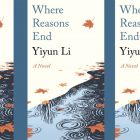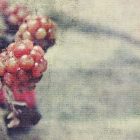Weasels in the Attic’s Exploration of Parenthood

Strange animals abound in the short novels of Hiroko Oyamada. In The Factory, published in an English translation from the Japanese by David Boyd in 2019, washer lizards evolve in the habitat provided by the nameless factory’s washing machines, where they eat insects, detergent, and dust; grayback coypus build their dens in the factory’s many drains along a river; and black shags flock along the shore where the river meets the ocean and seem never either to die or to breed, although their numbers keep growing. In The Hole, also translated by Boyd and published in English in 2020, an unidentifiable creature—the size of a retriever with black fur, thin legs, a bulky body, and exposed ribs—leads the narrator toward the hole she falls into. And Weasels in the Attic, the most recent of Oyamada’s works to be translated by Boyd, released in English earlier this month, teems with tropical fish and the eponymous weasels, whose lives and deaths reveal the precariousness of parenthood and family.
Weasels in the Attic is a collection of three stories originally published separately in Japan. All three feature the same unnamed narrator, his wife, and Saiki, his friend since college. The first story, “Death in the Family,” tells about an evening the narrator spends with Saiki and Saiki’s friend Urabe, who lives with his much younger wife and baby in an apartment above the abandoned shop where he once sold tropical fish. The second story, “The Last of the Weasels,” concerns the weasels that are getting into the country home Saiki moved into with his new wife, Yoko; on a visit with Saiki and Yoko, the narrator’s wife tells a harrowing tale that offers a possible solution to the problem with the weasels. The final story, “Yukiko,” tells about an evening the narrator and his wife spend with Saiki and Yoko shortly after the birth of their baby, Yukiko, when an unexpected snowstorm keeps them in their friends’ home all night.
Questions about fertility run through the book. In three years of marriage, the narrator and his wife have been unable to conceive a child, and discussions of whether and how to pursue fertility treatments have become a “nightly routine.” The narrator tells Saiki, “It’s the same thing every night. Then she asks me: ‘On a scale of one to ten, how badly do you want kids?’” Saiki responds, “Man. What can you even say to that?” The narrator doesn’t say what he tells his wife, but later, holding Urabe’s baby, he says, “I could feel her warmth and dampness through the layers of cloth. I’ve always liked kids. I wished I could have one of my own. I couldn’t give it a number, but I knew it was what I wanted.” It’s a rare moment of vulnerability and openness from the otherwise matter-of-fact narrator—though he admits his wish only to himself and readers, not to his wife or friend.
Despite his desire for a child, the narrator later seems surprised to see how fatherhood has changed his friend. When Yoko says that Saiki “does everything from morning to evening” except feed the baby, the narrator exclaims, “Wait, so he changes her diapers?” “The Saiki I knew wasn’t the type who voluntarily took care of any child—even his own. I was pretty sure he didn’t like kids,” he comments, possibly jealous, given that unlike Saiki he does like children and, when he was younger, helped take care of his sisters’ children, playing with them and singing them lullabies. The narrator then laughs when Saiki, speaking to his baby daughter, refers to himself as “dada.” The narrator does not say whether his surprise is that any man should claim such a name for himself or that Saiki in particular is claiming this name. As for Saiki, he views the name practically: “It’s too hard for her to say anything else. I’m going to be ‘dada’ until she can actually talk.”
Meanwhile, all around the narrator, animals propagate. There are the weasels that seemingly cannot be exterminated from Saiki’s home—“We’re going to live out the rest of our days among the weasels, way out here in the middle of nowhere,” he complains to the narrator—and the one time the narrator visits Urabe, he sees that his living room is lined with tanks filled with fish, many of them discus, which Urabe breeds.
According to Urabe’s wife, the breeding is experimental; she says, “We still don’t fully understand the relationship between genotype and phenotype. We haven’t been able to confirm which genes lead to which patterns.” According to Urabe, there is as much intuition as intention behind his approach. Choosing mates for fish, he claims, is not so different from how humans choose their mates: “We live our lives in the groups we have—in our cities, our countries, even though we didn’t choose them. Know what I mean? We like to tell ourselves it’s love, that we’re choosing our own partners. But in reality, we’re just playing the cards we’ve been dealt.”
Urabe’s detached view of family relationships appears not to be merely philosophical. He displays no affection for either his baby or his wife, who scrambles to get food to serve him and his guests. Neither the narrator nor Saiki know what to make of his death only six months later, or why his wife—to whom he may not actually have been married—does not come to his funeral. Nor does she even seem to have been living with him at the time of his death; most of his fish died because, as Saiki tells the narrator, “Urabe was dead for a few days before anyone knew anything.”
Propagation does not guarantee flourishing. As Urabe says of his fish, “Some lay lots of eggs, others don’t. But quantity doesn’t necessarily mean anything.” And so, though the stories are suffused with the narrator’s uncertain longing, they each also contain warnings: Urabe’s sudden and unexpected death in “Death in the Family,” for example, or the horrifying shrieks of a drowning mother weasel in “The Last of the Weasels.” In “Yukiko,” a warning comes from Saiki, who is raising tropical fish in his new home. The fish live in tanks in the room where the narrator and his wife sleep, and in a terrifying episode of sleep paralysis, the narrator dreams that one of the fish—a bonytongue, long and silver, the fish the narrator likes best—has leapt out of its tank and landed on him, weighing him down. “I could feel the bonytongue twisting,” he says. “It had to be in pain. If it died like this, Saiki was going to be upset. I didn’t want this fish dying on top of me. I tried to raise my voice—to say something. I couldn’t even get my tongue to move.” The narrator is as helpless as the fish—and then he wakes up. The fish is in its tank, its scales shining. “I can really see the appeal of tropical fish. Maybe I should get some of my own,” he says to Saiki, after his terror has been dispelled in the morning light. “Don’t do it, man,” Saiki says, warning of the work involved. “I know they look pretty, but they’re living things.”
This time is not the first that Saiki has told the narrator not to get fish. After the narrator learned of Urabe’s death and suggested that he might take one of his surviving breeding pairs of discus, Saiki said, “Don’t do it. I know Urabe made it look easy, but they’re tricky fish.” This time, Saiki’s advice lands more heavily. He is a father now, and unlike Urabe, whose detachment might have also made fatherhood “look easy,” Saiki has allowed fatherhood to change him. He appears acutely aware of his vulnerability and that of those around him: fretting about an impending snowfall, wearing a bright red jacket so that he isn’t mistaken for a boar and shot (as can happen in the country), changing diapers, calling himself “dada.” The narrator may laugh, and Saiki himself may seem weary, but such behavior is what parenting requires, though of course nothing can guarantee the safety of a family.



